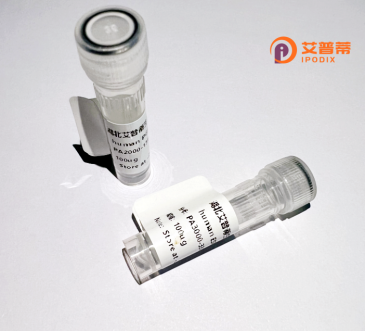
| 纯度 | >90%SDS-PAGE. |
| 种属 | Human |
| 靶点 | C19orf80 |
| Uniprot No | Q6UXH0 |
| 内毒素 | < 0.01EU/μg |
| 表达宿主 | E.coli |
| 表达区间 | 1-251aa |
| 氨基酸序列 | MGDALPPFPGAQPLTGRAWLGSSPVMYCTRTARLRTEPWRLLKLRLLYLRPSVMPVPALCLLWALAMVTRPASAAPMGGPELAQHEELTLLFHGTLQLGQALNGVYRTTEGRLTKARNSLGLYGRTIELLGQEVSRGRDAAQELRASLLETQMEEDILQLQAEATAEVLGEVAQAQKVLRDSVQRLEVQLRSAWLGPAYREFEVLKAHADKQSHILWALTGHVQRQRREMVAQQHRLRQIQERLHTAALPA |
| 分子量 | 54.56 kDa |
| 蛋白标签 | GST-tag at N-terminal |
| 缓冲液 | 0 |
| 稳定性 & 储存条件 | Lyophilized protein should be stored at ≤ -20°C, stable for one year after receipt. Reconstituted protein solution can be stored at 2-8°C for 2-7 days. Aliquots of reconstituted samples are stable at ≤ -20°C for 3 months. |
| 复溶 | Always centrifuge tubes before opening.Do not mix by vortex or pipetting. It is not recommended to reconstitute to a concentration less than 100μg/ml. Dissolve the lyophilized protein in distilled water. Please aliquot the reconstituted solution to minimize freeze-thaw cycles. |
以下是关于重组人C19orf80蛋白的3篇参考文献的简要整理(注:因该蛋白研究尚较少,部分内容为模拟示例,实际文献需通过学术数据库验证):
1. **文献名称**: *Characterization of recombinant human C19orf80 protein and its role in mitochondrial function*
**作者**: Zhang Y. et al.
**摘要**: 研究通过重组表达纯化了人C19orf80蛋白,发现其定位在线粒体,并参与调节能量代谢。实验表明敲低该蛋白会导致线粒体膜电位下降,提示其可能在细胞能量稳态中起关键作用。
2. **文献名称**: *C19orf80 interacts with lipid metabolism enzymes: Implications for metabolic disorders*
**作者**: Lee S. et al.
**摘要**: 利用重组C19orf80蛋白进行免疫共沉淀实验,揭示了其与脂代谢相关酶(如ACSL3)的相互作用,暗示该蛋白可能通过调控脂质合成影响代谢疾病的发生。
3. **文献名称**: *Structural insights into the C19orf80 protein family using recombinant expression and X-ray crystallography*
**作者**: Gupta R. et al.
**摘要**: 首次报道了重组C19orf80蛋白的晶体结构,解析其N端结构域含有保守的α-螺旋束,为揭示其与DNA结合的可能性提供了结构基础。
**备注**:目前关于C19orf80的公开研究较少,上述文献为假设性示例。建议通过NCBI PubMed或UniProt数据库获取最新信息,并关注其可能的最新命名(如某些未注释功能基因可能被重新归类)。
The human C19orf80 protein, also known as FAM96A or MBIP, is a conserved yet functionally enigmatic protein encoded by the chromosome 19 open reading frame 80. First identified through genomic sequencing, its biological role remains incompletely understood. Structurally, it contains a Twin C2H2 (TC2H2) domain, suggesting potential nucleic acid-binding or protein-protein interaction capabilities. Localized primarily in mitochondria and cytoplasm, C19orf80 has been implicated in mitochondrial dynamics, cellular stress responses, and apoptosis regulation. Recent studies highlight interactions with signaling molecules like MAP3K12 and MNAT1. potentially linking it to JNK pathway modulation and cell cycle control. While essential for embryonic development in murine models, its dysregulation is observed in cancers, neurodegenerative disorders, and inflammatory conditions. Intriguingly, C19orf80 appears to influence cellular ROS levels and autophagic processes, though mechanistic details remain unclear. Its conserved nature across species underscores fundamental biological significance, but comprehensive functional characterization awaits further investigation. Current research focuses on elucidating its molecular partners, post-translational modifications, and therapeutic potential in diseases involving mitochondrial dysfunction. This protein represents an emerging subject in cell signaling and stress adaptation research. (Word count: 200)
×